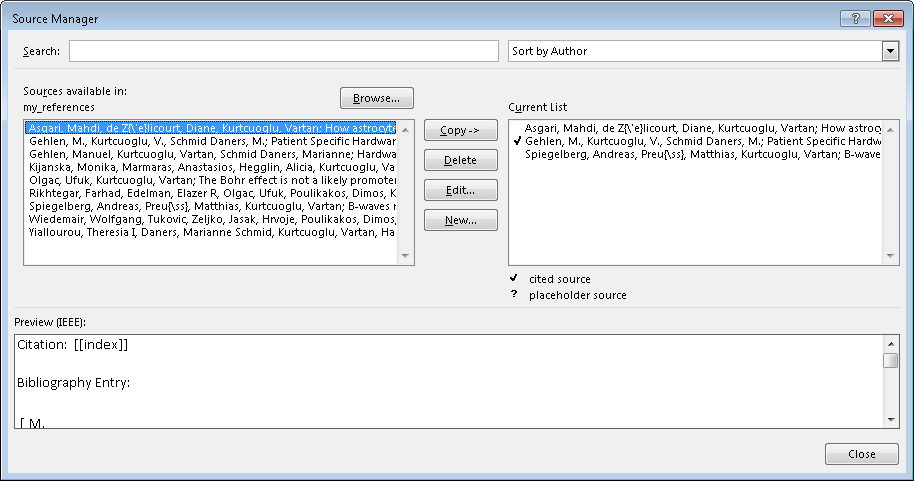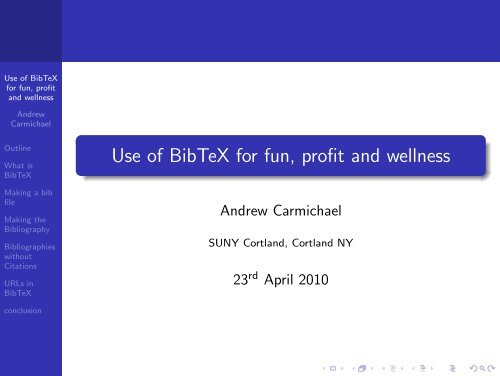Export (selected) entries in JabRef and choose Office 2007 XML format Open Word, click on the References Tab Click on Manage sources - Browse - Open the exported XML File (or better copy it directly to the location under browse) All entries are then available in the MS bibliography database. The word, BibTeX ' stands for a tool and a file format which are used to describe and process lists of references, mostly in conjunction with LaTeX documents. Here you can learn about the BibTeX File Format, How to use BibTeX and BibTeX Tools which can help you to ease your BibTeX usage. NEW: Be sure to try the Bib2x Online Converter which allows you to convert your BibTeX bibliographies into a few target formats. Once you download the BibTex file, you can import it into your reference manager of choice. If you use Microsoft Word to collect, manage, and cite papers, please follow the steps below to import the file and cite the paper in Microsoft Word: Note the folder where the citation file was downloaded. Click Manage Sources in Microsoft Word. There is probably no converter available that could convert.bibtex files directly to Word documents (.doc). However, you should be able to export BIBTEX as PDF, and latest Microsoft Word can open PDF which could then be saved as Word documents, which means you can achieve bibtex to doc conversion this way. Updated: June 10, 2020. LaTeX is a powerful tool for creating documents. With LaTeX you are not worry about how the document will look but document's structure. BibTeX is a compleme.
Overview

Bibtex4Word is a useful Word add-in that allows you to use your existing BibTeX database and favorite bibliography styles in Word.
Bibtex And Overleaf

Installation
To use Bibtex4Word (which only works on a PC) you will need to install the following:
- JabRef (well, actually any reference manager that will allow you to keep track of your BibTex database, but a number of people in the lab prefer JabRef)
- MikTex
- Bibtex4Word macro
There are excellent installation instructions and test documents available at the Bibtex4Word site: http://www.ee.ic.ac.uk/hp/staff/dmb/perl/index.html
Use
It is fairly straightforward to use Bibtex4Word once everything is installed. Check out the user guide here: http://www.ee.ic.ac.uk/hp/staff/dmb/perl/b4w_using.html

Notes
Please feel free to post comments, questions, or improvements to this protocol. Please sign your name to your note by adding ''*~~~~'': to the beginning of your tip.
*Megan N McClean I ran into several problems when trying to get this to work. I am running Windows 7, 32-bit. My solutions were as follows:
- I could not for the life of me get MikTex to install on my computer. Everytime I ran the installer I would get the following error:
An error occurred:
source file: LibrariesMiKTeXCoreProcess.cpp

source line: 296
message: The operation failed for some reason.
info: C:Program FilesMiKTeX 2.8miktexbininitexmf.exe
I eventually fixed this following the recommendations here: http://entangled.wordpress.com/2009/09/18/installation-of-miktex-2-8-failed/I did all of the following:
Bib To Xml
- Uninstalled Adobe Reader and restarted my computer
- Installed MikTex 2.8 instead of 2.9
- Installed MikTex for just myself, instead of all users on the computer
- Installed MikTex in my Documents folder, instead of in C:Programs
- Changed PDF permissions by running regedit.exe from the search line, navigating to HKEY_CLASSES_ROOT.pdf, rightclicking .pdf, clicking permissions, and granting everyone full rights (Full Control, Read) to .pdf (that is, administrator, myself, Restricted, and system)
- The first time I tried to find Windows 7: C:Users*****AppDataRoamingMicrosoftWordSTARTUP to put the .dot file in the Word startup folder, I could not find the AppData folder. Turns out, you actually need to follow the Bibtext4Word installation instructions and change Windows options so that you can see hidden folders: Control Panel->Appearance and Personalization->Folder Options->Show hidden files and folders. In the dialog box that pops up click Show hidden files, folders, and drives, and unclick Hide extensions for known file types, and Hide protected operating system files (Recommended)
Bibtex Word Mac

- When you want to install a new bibtex style, save the .bst file into MikTex->Bibtex->bst->base. To update BibTex's list of styles, you then need to run texhash from a command window (i.e. run cmd from the start menu, and then type texhash and hit enter, hurray, all done!). Then restart Microsoft Word to use the new style.